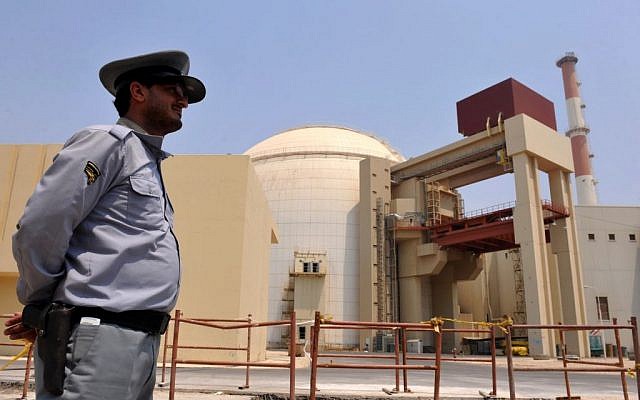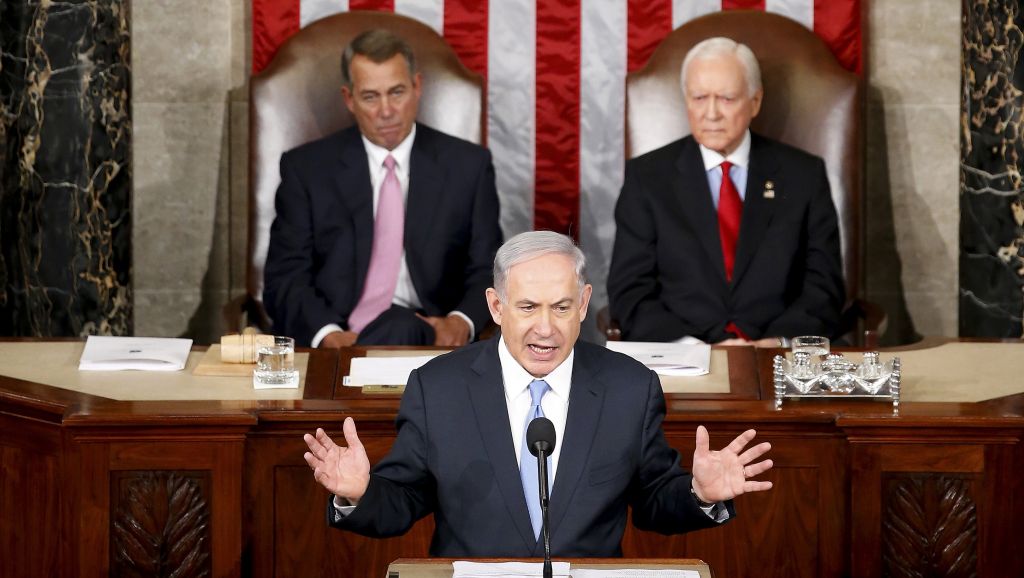
A previously secret addendum to the internationally negotiated nuclear deal with Iran reinforces Israeli concerns over the agreement and Iran’s ability to rush towards the bomb if it so chooses, an Israeli government official said Monday.
The senior official told The Times of Israel that Jerusalem’s greatest concern about the nuclear deal with Iran “was and remains that after about 10 years, it would leave Iran with an industrial uranium enrichment capacity that would enable the regime to produce the fuel for many nuclear bombs in a very short time.”
The nuclear agreement “removes the restrictions on Iran’s nuclear program based on dates certain, rather than on changes in Iran’s aggressive behavior, including its support for terrorism around the world,” the senior official said. “The deal doesn’t solve the Iranian nuclear problem, but rather delays and intensifies it.”
According to the secret document, obtained Monday by The Associated Press, key restrictions on Iran’s nuclear program imposed under the accord will ease in slightly more than a decade, cutting the time Tehran would need to build a bomb to six months or less from present estimates of a year.
The document is the only part linked to last year’s deal between Iran and six foreign powers that hasn’t been made public. It was given to the AP by a diplomat whose work has focused on Iran’s nuclear program for more than a decade, and its authenticity was confirmed by another diplomat who possesses the same document.
Israel’s Prime Minister Benjamin Netanyahu has led opposition to the deal, even addressing Congress in March 2015 to lobby against it, to the intense irritation of US President Barack Obama. Netanyahu has argued that far from preventing Iran attaining nuclear weapons, the accord paves the way for Iran to build a nuclear weapons arsenal.

The diplomat who shared the document with the AP described it as an add-on agreement to the nuclear deal. But while formally separate from that accord, he said that it was in effect an integral part of the deal and had been approved both by Iran and the US, Russia, China, Britain, France and Germany, the six powers that negotiated the deal with Tehran.
Details published earlier outline most restraints on Iran’s nuclear program meant to reduce the threat that Tehran will turn nuclear activities it says are peaceful to making weapons.
But while some of the constraints extend for 15 years, documents in the public domain are short on details of what happens with Iran’s most proliferation-prone nuclear activity — its uranium enrichment — beyond the first 10 years of the agreement.
The document obtained by the AP fills in the gap. It says that as of January 2027 — 11 years after the deal was implemented — Iran can start replacing its mainstay centrifuges with thousands of advanced machines.
Centrifuges churn out uranium to levels that can range from use as reactor fuel and for medical and research purposes to much higher levels for the core of a nuclear warhead. From year 11 to 13, says the document, Iran can install centrifuges up to five times as efficient as the 5,060 machines it is now restricted to using.
Those new models will number less than those being used now, ranging between 2,500 and 3,500, depending on their efficiency, according to the document. But because they are more effective, they will allow Iran to enrich at more than twice the rate it is doing now.
The US says the Iran nuclear agreement is tailored to ensure that Iran would need at least 12 months to “break out” and make enough weapons grade uranium for at least one weapon.
But based on a comparison of outputs between the old and newer machines, if the enrichment rate doubles, that breakout time would be reduced to six months, or even less if the efficiency is more than double, a possibility the document allows for.
The document also allows Iran to greatly expand its work with centrifuges that are even more advanced, including large-scale testing in preparation for the deal’s expiry 15 years after its implementation on Jan. 18.
It doesn’t say what happens with enrichment past year 13. That indicates a possible end to all restrictions on the number and kind of centrifuges even while constraints on other, less-proliferation prone nuclear activities remain until year 15.
And that time frame could shrink even more. While the document doesn’t say what happens with centrifuge numbers and types past year 13, US Energy Secretary Ernst Moniz told The AP that Iran will be free to install any number of advanced centrifuges beyond that point, even though the nuclear deal extends two additional years.
That will give Iran a huge potential boost in enrichment capacity, including bomb making should it choose to do so. But it can be put to use only after the deal expires.
Moniz noted that the limit on the amount of low-enriched enriched uranium Iran will be allowed to store will remain at 300 kilograms (660 pounds) for the full 15 years, significantly below the amount needed for further enrichment into a bomb. As well, the stockpile will remain restricted to a level used for reactor fuel that is well below weapons grade.
These restrictions translate into “serious constraints on … (Iran’s) nuclear program for 15 years,” Moniz said.
In selling the deal to skeptics, the U.S. administration said it is tailored to ensure that Iran would need at least 12 months to “break out” and make enough weapons grade uranium for at least one weapon. Moniz said the document obtained by the AP posed no contradiction to that claim because “we made it very clear that we were focused on 10 years on the minimum one-year breakout time.”
The document also notes that Iran will greatly expand its work with centrifuges that are even more advanced, including large-scale testing in preparation for the deal’s expiry 15 years after its implementation on Jan. 18.
But State Department spokesman Mark Toner said that “the prohibition on Iran’s pursuit of a nuclear weapon — and our ability to monitor the peaceful nature of its nuclear program — remains in effect indefinitely.
“The breakout time does not go off a cliff nor do we believe that it would be cut in half, to six months, by year 11,” he said.
Iran insists it is not interested in nuclear weapons, and the pact is being closely monitored by the International Atomic Energy Agency. The IAEA says Tehran has essentially kept to its commitments since the agreement was implemented, a little more than six months after Iran and the six powers finalized it on July 14, 2015.
Marking the agreement’s anniversary Thursday, President Barack Obama said it has succeeded in rolling back Iran’s nuclear program, “avoiding further conflict and making us safer.” But opposition from US Republicans could increase with the revelation that Iran’s potential breakout time would be more than halved over the last few years of the pact.
Also opposed is Israel, which in the past has threatened to strike Iran if it deems that Tehran is close to making a nuclear weapon. Alluding to that possibility, David Albright, whose Washington-based Institute for Science and International Security is a US government go-to resource on Iran’s nuclear program, said the plan outlined in the document “will create a great deal of instability and possibly even lead to war, if regional tensions have not subsided.”
The deal provides Iran with sanctions relief in exchange for its nuclear constraints. But before going into recess, US Congress last week approved a bill to impose new sanctions for Tehran’s continuing development and testing of ballistic missiles, a program the White House says is meant to carry atomic warheads even if it is not part of the nuclear agreement.
It also approved a measure that calls for prohibiting the Obama administration from buying more of Iran’s heavy water, a key component in certain nuclear reactors.
The White House has said removing the country’s surplus heavy water denies Tehran access to a material that may be stored for potential nuclear weapons production. But critics note that the purchase was made only after Iran exceeded heavy water limits proscribed by the nuclear deal and assert it rewarded Tehran for violating the agreement.
